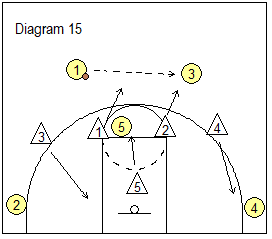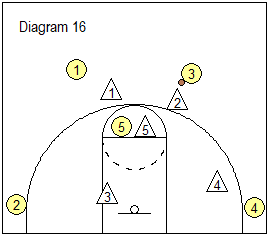Basketball Defense - the 4-1 Chameleon Defense
From Tyler Whitcomb and Andrew Howard - Coach’s Clipboard Basketball PlaybookThis basketball article describes the 4-1 Chameleon defense by coaches Tyler Whitcomb and Andrew Howard. This half-court defense would be categorized as a "special" or "junk" defense. You should not base your entire defense on this scheme, but use it in special situation, like you might use the Amoeba defense.
Coach Tyler Whitcomb is the boys head basketball coach at West Michigan Aviation Academy and was a former pro basketball GM and scout. In his young career, he already has over 100 high school coaching victories.

Coach Tyler Whitcomb
Why Use the 4-1 Defense?
- It confuses the offense. The first thing the offense does is try to find out what defense you are in so they can get in the proper offense. With this defense nobody knows.
- It's great after a timeout. When the opponent calls a timeout to draw up a play, nobody has a 4-1 defense play.
- You do not have to use all of this defense's variations to successfully use the 4-1 defense.
- Use the 4-1 as a complement to your regular defense(s), not your main, primary defense.
4-1 Defense Set-Up
Line four defenders 2-3 steps above the free-throw line extended (diagram 1). This front line has to stand close enough together where they do not get split by a pass. We allow a few passes around the perimeter before we start trapping. Once the ball is passed to the corner, we are in our "Fire" defense (below). We want the ball skipped to the corner so we can trap and rotate.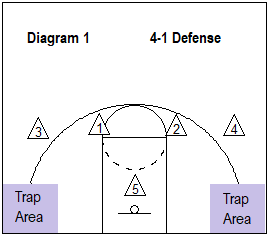
"4-Fire" and Rotations
As soon as O1 dribbles across half-court (diagram 2), our top defenders get "bouncy", stunting, trying to intimidate the offense. The front line defenders must be close enough together so they do not get split by a pass. We allow a few passes around the perimeter before we start trapping. Once the ball is passed to a corner we are in our defense.When the ball is skip-passed to a corner (diagram 3), players rotate quickly on the flight of the ball. X4 and X5 trap the ball in the corner. X1 denies the middle. X3 sprints down to guard the basket. X2 denies the reversal pass to O4.
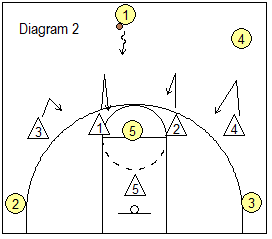
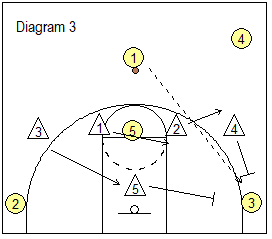
If the ball is skip-passed out to the opposite wing (diagram 4), all defenders sprint on the flight of the ball. X1 and X2 trap the ball. X4 denies the middle. X3 denies the reversal pass to O2. X5 protects the basket.
When we have a good trap (diagram 5), the trappers try to tip the ball and avoid reaching in and fouling. They must be close together so the offensive player cannot split the trap with a dribble.
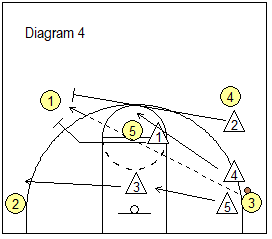
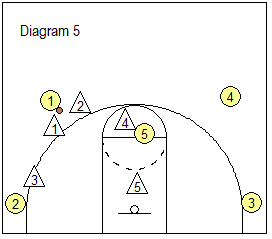
"4-Blast"
When O1 dribbles across half-court, X1 and X2 sprint up to stop and double-team the ball (diagram 6). X3 and X4 deny the wing passes. X5 stunts the middle but does not actually deny the middle. If the ball is passed into O4 in the middle, X5 will play cat and mouse until the defense can recover.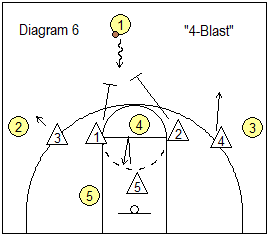
41 to 2-3 Zone
We can start in the 4-1 setup, and then change to a zone on the first pass. Diagram 8 shows rotation from the 4-1 set into a 2-3 zone defense (diagram 8b), triggered by the first pass.X1 denies the middle. X2 closes-out on the ball. X4 holds on the ball until X2 arrives and then "bumps" down to become the strongside low defender. X5 takes the middle and X3 becomes the low weakside defender. Now just follow your usual 2-3 zone rules.
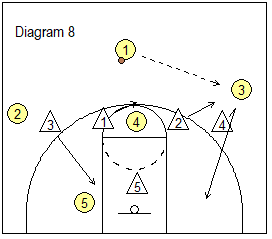
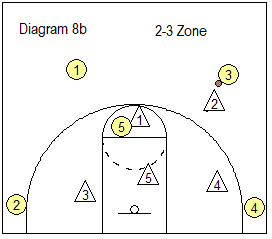
41 to 1-2-2 Zone
Starting in the 4-1 setup, we change to a 1-2-2 zone on the first pass (diagram 9).X1 takes the top of the zone (diagram 10). X2 closes-out on the ball. X3 denies the middle. X4 drops to cover the ballside corner. X5 protects the basket and becomes the other low defender. From here, use your normal 1-2-2 zone rules.
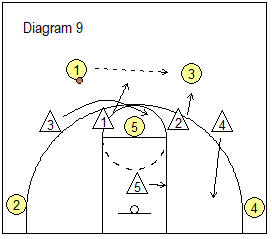
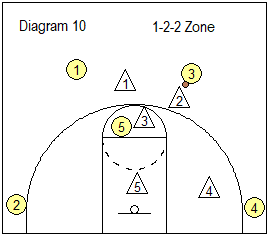
41 to 1-3-1 Zone
Starting in the 4-1 setup, we morph into a 1-3-1 zone on the first pass (diagram 11). X1 becomes the top defender. X2 denies the middle, while X3 and X4 take the wings. X5 is the low middle defender. From here (diagram 12), use your normal 1-3-1 zone rules.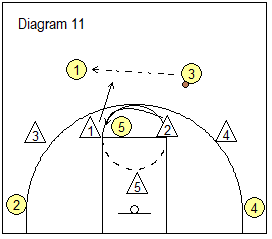
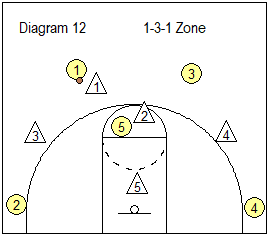
41 to 3-2 Zone
Starting in the 4-1 setup, we change into a 3-2 zone on the first pass (diagram 13). X1 denies the middle. X2 moves to the strongside wing. X3 becomes the weakside wing defender. X4 drops to the ballside corner, and X5 protects the basket and becomes the opposite low defender. From here (diagram 14), use your normal 3-2 zone rules.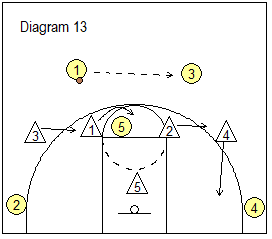
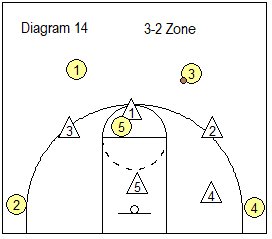
41 to Man-to-Man
Starting in the 4-1 setup, we go to man-to-man defense on the first pass (diagram 15). On the flight of the ball, everyone matches up man-to-man. You can adjust your initial spots in the 4-1 set so that you get the right match-ups, and avoid any mis-matches. Then just run your usual man-to-man defense and rules (diagram 16).